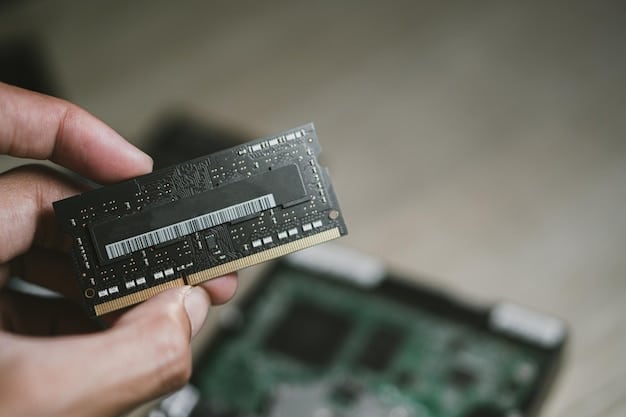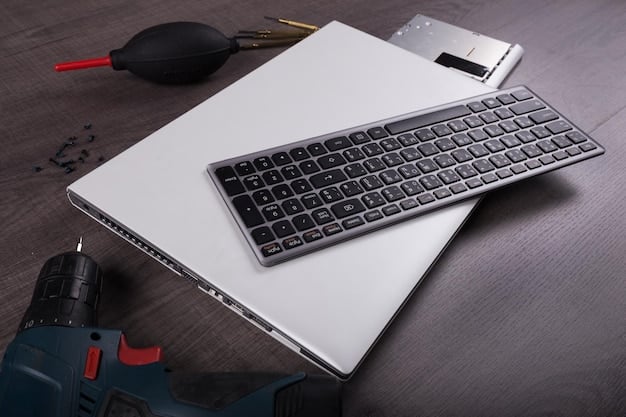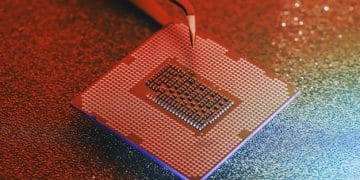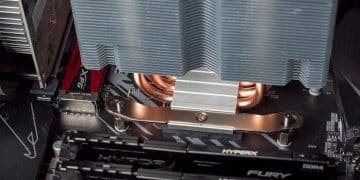How to Upgrade Your Laptop’s RAM for Improved Performance: A Step-by-Step Guide

Upgrading your laptop’s RAM is a cost-effective way to boost performance, allowing for smoother multitasking and faster application loading; this guide provides a step-by-step process to upgrade RAM.
Is your laptop feeling sluggish? One of the easiest and most effective ways to breathe new life into your machine is to upgrade its RAM. In this guide, we’ll walk you through how to upgrade your laptop’s RAM for improved performance, making it feel like new again.
Why Upgrade Your Laptop’s RAM?
Before diving into the process, let’s discuss why upgrading your laptop’s RAM is a worthwhile investment. RAM, or Random Access Memory, is crucial for your laptop’s ability to handle multiple tasks simultaneously. More RAM means your laptop can run more applications smoothly and efficiently.
Upgrading RAM can lead to significant improvements in several areas.
Improved Multitasking
One of the primary benefits of upgrading RAM is enhanced multitasking capabilities. When you have more RAM, your laptop can handle more applications and processes running simultaneously without slowing down.
Faster Application Loading
More RAM also translates to faster application loading times. Applications can load and run more quickly, improving overall productivity and user experience. It also provides a better experience with video editing or graphic-intensive games.
Enhanced System Responsiveness
With enough RAM, your system becomes more responsive. Tasks like opening files, browsing the web, and switching between applications become smoother and faster.

- Increased Productivity: Faster application loading and smoother multitasking mean you can get more done in less time.
- Improved Gaming Experience: Gamers will appreciate the smoother gameplay and reduced lag that comes with more RAM.
- Extended Laptop Lifespan: Upgrading RAM can extend the lifespan of your laptop by keeping it relevant and efficient for longer.
Upgrading your laptop’s RAM is a simple way to get more mileage out of your device. Now, let’s move on to how you can determine if your laptop is a good candidate for such an upgrade.
Is Your Laptop RAM Upgradeable?
Not all laptops are created equal, and not all laptops allow for RAM upgrades. Before you start, it’s important to determine if your laptop’s RAM is upgradeable.
The answer to this question depends on your laptop’s design and specifications.
Checking Laptop Specifications
One of the best ways to determine if your laptop’s RAM is upgradeable is to check its specifications. You can usually find this information on the manufacturer’s website or in the laptop’s manual.
Identifying RAM Type and Speed
When upgrading RAM, it’s crucial to know the type and speed of RAM that your laptop supports. The type of RAM refers to the generation, such as DDR3, DDR4, or DDR5. The speed refers to the clock speed, measured in MHz.
Consulting the Laptop’s Manual
The laptop’s manual is a valuable resource for determining RAM compatibility and upgrade options. Be sure to read it carefully before making any decisions.
Many modern ultrabooks and slim laptops have RAM that is soldered directly onto the motherboard, making it non-removable and non-upgradeable. If your laptop falls into this category, upgrading RAM is not an option.
If your laptop does allow for RAM upgrades, the next step is to gather the tools and materials you’ll need for the job.
Tools and Materials You’ll Need
Upgrading your laptop’s RAM is a straightforward process, but it requires a few essential tools and materials.
Having the right tools on hand will make the process smoother and safer.
Screwdriver Set
A high-quality screwdriver set with various sizes and types is essential for opening your laptop. Opt for a set that includes Phillips head and flathead screwdrivers.
Anti-Static Wrist Strap
An anti-static wrist strap is crucial for preventing electrostatic discharge, which can damage sensitive electronic components like RAM modules.
New RAM Modules
Purchase the correct type and speed of RAM modules that are compatible with your laptop. Ensure they meet the specifications outlined in your laptop’s manual.

- Organization: Keep your workspace tidy and organized to prevent losing small screws and components.
- Safety: Always unplug your laptop and remove the battery before starting the upgrade process.
- Compatibility: Double-check that the new RAM modules are compatible with your laptop’s specifications.
Having the right tools and materials will make this process safer and more efficient. With everything prepared, you’re equipped to move on to the next stage: initiating the upgrade.
Step-by-Step Guide to Upgrading RAM
Now that you have everything you need, let’s dive into the step-by-step process of upgrading your laptop’s RAM. This process is generally straightforward, but it’s important to follow each step carefully to avoid any issues.
Follow these steps to upgrade your laptop’s RAM successfully.
Step 1: Power Off and Unplug Your Laptop
Before you start, power off your laptop completely and unplug it from any power source. Remove the battery if possible to prevent electrical shock or damage to the components.
Step 2: Open the Laptop Casing
Use the screwdriver to carefully remove the screws holding the laptop’s casing together. Keep the screws organized to make reassembly easier.
Step 3: Locate the RAM Slots
Once the casing is open, locate the RAM slots on the motherboard. They are usually covered by a metal shield or easily identifiable due to their distinctive shape.
Step 4: Remove the Old RAM Modules
If there are already RAM modules in the slots, gently push the clips on either side of the module outwards. The module should pop up, allowing you to remove it.
Step 5: Insert the New RAM Modules
Align the notch on the new RAM module with the notch in the RAM slot. Push the module firmly into the slot until the clips on either side click into place, securing the module.
Step 6: Reassemble the Laptop
Once the new RAM modules are securely in place, reassemble the laptop casing by replacing the screws. Ensure everything is properly aligned before tightening the screws.
By following these steps carefully, you can ensure a smooth and successful RAM upgrade process. It’s now time to test and verify the upgrade.
Testing and Verifying the Upgrade
After you’ve upgraded your laptop’s RAM, it’s important to test and verify that the new RAM modules are functioning correctly.
Testing helps ensure your laptop recognizes and utilizes the new RAM efficiently.
Check System Information
One of the simplest ways to verify the upgrade is to check your laptop’s system information. This will show you the amount of RAM that your laptop is recognizing.
Run Memory Diagnostic Tools
Memory diagnostic tools can help identify any issues with the new RAM modules. These tools perform various tests to ensure the RAM is functioning correctly.
Monitor Performance
Pay attention to how your laptop performs after the upgrade. You should notice improvements in multitasking, application loading, and overall responsiveness.
- System Stability: Ensure that your laptop is stable and doesn’t crash or freeze unexpectedly.
- Application Performance: Test resource-intensive applications to see if they run more smoothly with the added RAM.
- Gaming Performance: If you’re a gamer, test your favorite games to see if the upgrade has improved performance.
These steps can help you confirm that the RAM upgrade was successful and your laptop is performing as expected. With a successful upgrade, you should notice a tangible improvement in your laptop’s performance.
Troubleshooting Common Issues
While upgrading your laptop’s RAM is generally straightforward, you may encounter some common issues during the process. Understanding these issues can help you troubleshoot and resolve them effectively.
Having basic troubleshooting knowledge is invaluable when dealing with hardware upgrades.
Laptop Not Recognizing New RAM
If your laptop is not recognizing the new RAM, the modules may not be properly seated in the slots. Ensure that they are fully inserted and the clips on either side are securely in place.
System Instability
System instability, such as frequent crashes or freezes, can be caused by faulty RAM modules or compatibility issues. Run memory diagnostic tools to identify if the RAM is the problem.
Blue Screen of Death (BSOD)
The dreaded Blue Screen of Death can indicate a hardware malfunction, including issues with the RAM. Check the error message for clues and consider testing the RAM modules individually.
- Compatibility: Always verify that the new RAM modules are compatible with your laptop’s specifications.
- Installation: Double-check that the RAM modules are properly installed and securely seated in the slots.
- Troubleshooting Tools: Utilize memory diagnostic tools to identify and address any issues with the RAM modules.
By addressing these common issues and following troubleshooting steps, you can resolve most problems that arise during or after a RAM upgrade. Upgrading your laptop’s RAM offers noticeable improvements in performance and extends the life of your machine, but you should always handle computer hardware with care.
| Key Point | Brief Description |
|---|---|
| 🚀 Improved Performance | Upgrading RAM boosts multitasking and app loading. |
| 🔧 Check Compatibility | Ensure new RAM matches laptop’s specs. |
| 🛠️ Essential Tools | Screwdriver set, anti-static wrist strap, new RAM. |
| ✅ Verify Upgrade | Test RAM using system info and diagnostics. |
Frequently Asked Questions
▼
RAM (Random Access Memory) is your laptop’s short-term memory, crucial for handling multiple tasks. More RAM allows smoother multitasking and faster application loading, improving overall system performance.
▼
Check your laptop’s specifications on the manufacturer’s website or in the manual. Look for details on maximum RAM capacity and if the RAM is soldered (non-upgradeable) or in removable slots.
▼
You’ll need a screwdriver set (Phillips and flathead), an anti-static wrist strap to prevent electrical damage, and the new RAM modules that are compatible with your laptop’s specifications.
▼
Common issues include the laptop not recognizing the new RAM, system instability, and the dreaded Blue Screen of Death. These can often be resolved by ensuring proper installation and RAM compatibility.
▼
Check your laptop’s system information to see if it recognizes the new RAM. Run memory diagnostic tools to test the RAM’s functionality and monitor your laptop’s performance for improvements in speed and stability.
Conclusion
Upgrading your laptop’s RAM can significantly improve its performance, making it faster and more efficient. By following this step-by-step guide, you can confidently upgrade your laptop’s RAM and enjoy a smoother computing experience.





